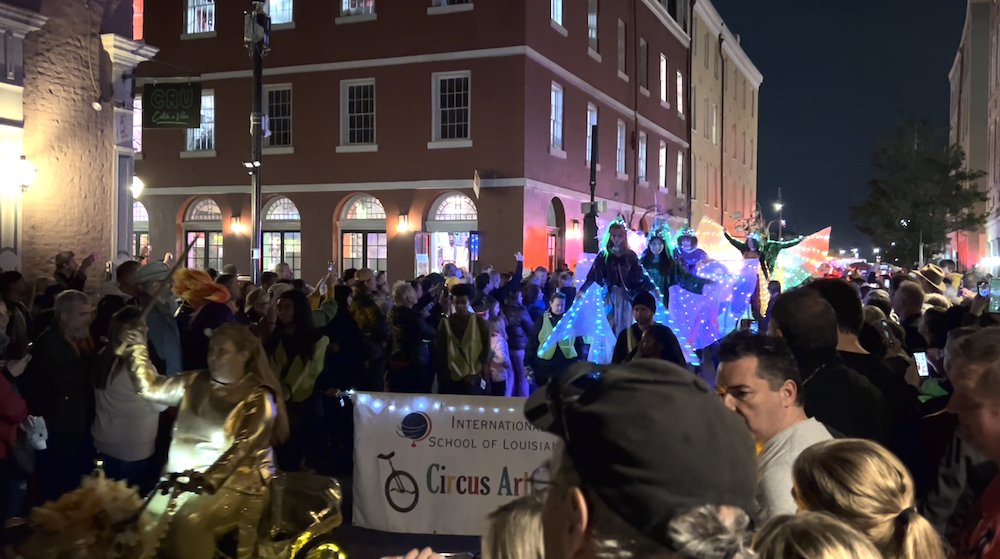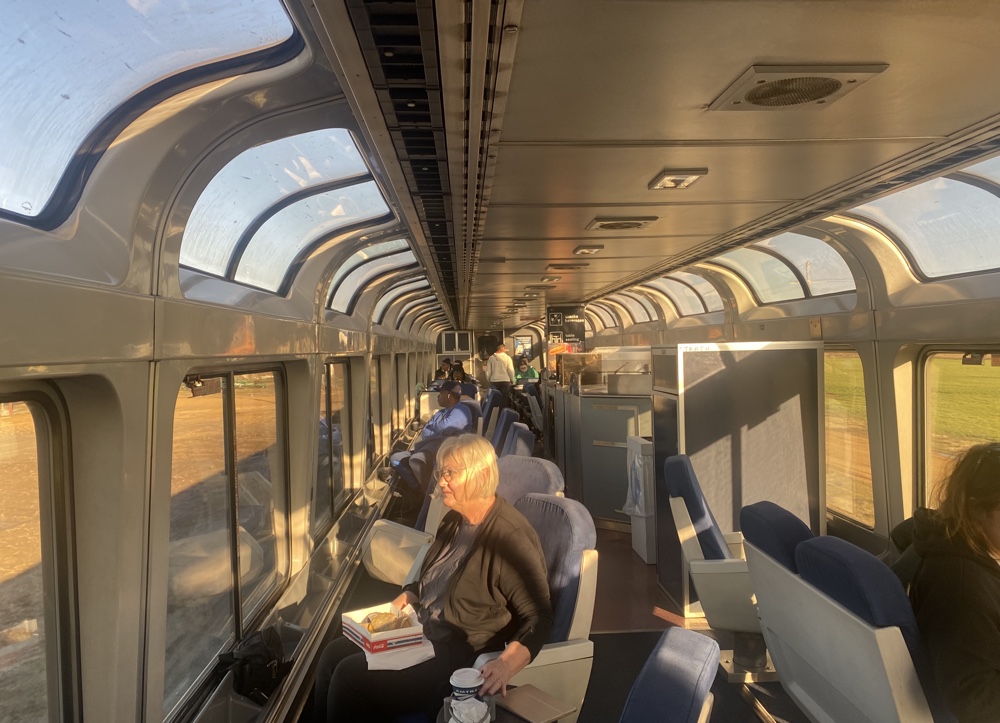
Tonight, we’re on our way back to Chicago from the Big Easy, riding on Amtrak’s City of New Orleans. My wife and I wanted to get out of Chicago for a few days, and since she’s an Amtrak employee, she’s generally trying to take as many long-distance rides as she can – so a ride down and back to New Orleans on a train during our son’s winter break brought a welcome change from routine.
The trip – and travelling on Amtrak – has been a tremendous success. We bought a “family room” for the 19-hour rides there and back, which puts us in a four bed private room on the lower level of a double-decker sleeper car, with access to four bathrooms and a shower on the car. We also get a choice of five different (pretty good!) hot meals delivered to us for breakfast, lunch, and dinner, along with complementary cocktails and drinks from one of a pair of train attendants serving our car.
The ride is quiet, not jerky at all (although you do rock back and forth), and the beds are surprisingly comfortable. You also get access to a double-decker lounge car which has a canteen on the bottom, and rows of couch-like chairs positioned along a bubble-like window that extends from floor to ceiling on both sides, providing a fantastic view of the landscape as it trundles by at an average 75-miles per hour.
And probably the biggest selling point of the whole trip for me: You skip all the hassles of air travel. The train departs Union Station in downtown Chicago, and arrives in New Orleans’ Warehouse District, your ticket is just checked once at the platform, and there’s no security theater – I even brought on a bag of fresh beignets I bought this morning in New Orleans.
The family room cost us about the same as three airline tickets there and back. The only difference is how much time we gave up. But! We arrived in town fresh and ready, saving perhaps four hours on each end with the usual deplaning/embarking, baggage, taxi, etc.
I would take a long-distance train again in a heartbeat.
This was probably my ninth or tenth trip to New Orleans, one of my favorite cities. Although the music is great, I go for the food, the relaxed vibe, and the chance to imagine living a slower life. My wife loves the architecture and parks, and my 14-year old son had never visited before. It was a great chance for all of us.
One thing that kept coming up for us was the reality of New Orleans’s hedonism – and addressing that with our son. It would be hard to call us prudes – I’ve just spent three years working in the cannabis industry – but there’s been a lot of talk about appropriate limits and how adults misbehave and can make poor judgements. New Orleans is swimming in alcohol – and sex – so there was a lot of talk about that. For instance: Get ready for that moment on Bourbon Street when you pass Larry Flynt’s Hustler Club. Also, unexpected things like people stumbling around the quarter on their way to becoming black-out drunk.
All that aside? So many amazing things to see. We loved visiting the Backstreet Museum in Tréme, which chronicles the “Indian” costumes of neighborhood tribes across the city. The World War II Museum was amazing and overwhelming. We’re all glad we went, but the death and destruction maxxed us out after three hours and we couldn’t handle more, even though we’d only looked at maybe half of the exhibits.
The streetcar rides, walking around the Garden District, thrift shopping on Magazine Street (a favorite pastime for my Gen Z-er), and strolling around the French Quarter and Marigny was glorious. Although in the past I would have stopped in a bar in each neighborhood, this time around I found it harder to find a decent place to stop and just have a coke with a teenager, especially in the Quarter.
We also got to see our first Mardi Gras parade, since the first parade of the season, a celebration of Joan of Arc’s birthday on January 7 (she liberated the city of Orleans, France, so…) kicked things off. Although it was a smaller parade (only about 30 minutes long) it was incredibly creative, showing the different stages of St. Joan’s life with whimsy and humor.

But the real star of our trip was food. The food! We ate at Galatoire’s, an ancient restaurant in the Quarter from the late 1800’s that specializes in simple seafood prepared perfectly. Also, Casamento’s, a Garden District seafood spot that shucks Gulf oysters faster than you can imagine. Cochon, a “whole pig” restaurant that was so-so, that made me think I could do better myself. The Ruby Slipper for brunch, a fabulous Mid-Town breakfast spot that has spread from New Orleans to Nashville and Birmingham over the last ten years. Muffulettas from Central Grocery for Nicolas and I. Loretta’s in Marigny with pralines and stuffed beignets for the road home.
And then there was Emeril’s. Oh wow. Wow.
First off, it was NOT CHEAP. A meal for the three of us was…NOT CHEAP. But the service. The level of food, the refinement. It was amazing. They brought a little stool for Teresa’s purse, so it wasn’t sitting on the floor while we ate. My martini was perfect. They had a list of interesting mocktails for Nicolas. My grilled redfish was probably the best fish I’ve ever had. Teresa swooned over her filet mignon. The wine pairing – fantastic. We had a terrific discussion with the manager (who was from Paris) about our France trip last summer and various restaurants, which resulted in us getting special treatment with a set of amuse bouche before and after the meal.
We couldn’t have asked for more, and for all of us, the experience was still warming our souls as we headed to the train station the next afternoon. This sort of dining experience is perfect to have – maybe once every three or four years. Although it’s crazy expensive, it reminds you that restauranting can be a high art.
And as I have each time I’ve visited over the last 18 years, I’ve wondered how New Orleans has been doing since Katrina. While I didn’t participate in Hurricane Katrina relief efforts, I did visit New Orleans in 2004, about a year before Katrina and then again in 2007, eighteen months after the disaster. Even almost two years later the town seemed deserted compared to the jam-packed city I remembered from 2004, and it was eerie driving through neighborhoods to still see spray-painted X’s on houses from teams that had checked for hurricane survivors.
There’s barely any physical trace of the hurricane now, and traffic levels seem back to normal. Trying to see if there was new insight to gain on the disaster, we stopped to check out the Katrina exhibit at the Louisiana State Museum in St. Charles Square. Disappointingly, it provided an overview of the disaster’s pain, but barely nods to FEMA’s incredibly delayed response, the devastation visited on Black communities versus white, and some of the worst crimes, like how the police arrested minorities willy-nilly for overblown looting charges and then chained them up in the blaring sun for days because the jail had been flooded.
But ask just a few questions of a local about Katrina’s impact, and you’ll learn that the mental scars are still there. One Lyft driver told us about her terrifying escape from town, you can see homes here and there that have been jacked up to prepare for future hurricanes – everyone has a story. And parts of the town are still recovering from 2021’s Hurricane Ida: The operators of the Backstreet Museum had to relocate because their old site was flooded, and Central Grocery is in the process of rebuilding their location on Decatur Street because of wind damage from Ida.
After wolfing down our muffuletta sandwiches on a park bench, Nicolas and I walked over to the riverfront. To get there you have to walk through a gate in the storm wall and then up a massive earthen berm. Standing on the berm, I pointed out to Nicolas how the river’s water level was actually a bit higher in elevation than Decatur Street in the French Quarter.
He was still, processing his observations, then said, “Wow. That’s not good.”
Done with the educational portion of the trip, we walked back through the storm gates, fast forgetting the city’s tenuous existence, swallowed up by the French Quarter’s human storm of culture and non-stop celebration.